
News + Trends
Samsung at MWC - all guns blazing on fibre optics, 5G and the Internet of Things
by Dominik Bärlocher

While tidying up my desk, I came across a smartwatch with a big smiley face. I'd almost forgotten about it, even though it's one of the strangest things I have in my already strange assortment of things on my desk. That you can buy this thing from us? Unthinkable.
I still remember exactly how I came across the MyKi Watch. Me and video editor Stephanie Tresch were on our way back to the hotel after a day at the Mobile World Congress (MWC) in Barcelona, where we were writing texts and editing videos. A gentleman approaches us with a large bag. The look in his eyes tells me that he wants to talk to me. He looks me straight in the eye.
I wonder if I know the gentleman.
Stephanie is also surprised.
As Swiss people, we are totally out of our depth in this situation, as no normal Swiss person ever speaks to someone on the street.
But the Lord speaks:
"Are you media?" he asks with a thick accent that sounds kind of Russian. Are we media? Yes. I'm a journalist, Stephanie is loaded down with almost 13 kilograms of camera equipment. I think you can tell, even if the circles under our eyes aren't visible after three almost sleepless nights due to the distance.
"Uh... yes," I reply.
"Very good. Have sample," says the man, hands me a packet and moves on to the next person, who he also asks if they are media. He hands them a packet too.
Stephanie and I are a bit perplexed. What had just happened here? We take a look at the item.
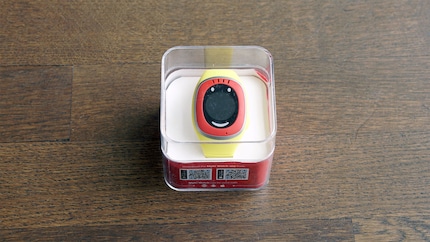
A smartwatch that was simply pressed into our hands. What's that all about?
It's a smartwatch with a big smiley face on it. For children? No idea. Operating instructions? Maybe it has them. The Russian who handed it to us is already far away. We put it in one of our bags and promptly forget about it. Until today. Because even if my desk usually looks as if a bomb has hit it, nothing ever actually gets lost. No matter what my employees say. When I'm tidying up, the watch falls into my hand again.
The clock starts up. A jingle rattles out of the undoubtedly cheap speakers. Jeez, that sounds bad.
Battery empty.
Okay, then we'll just hook the brightly coloured thing up to the supplied charging cable, which is fitted with LEDs. My desk looks like a Christmas tree.
All right, let's take a look at the packaging. The manufacturer of the device is MyKi, a manufacturer that obviously wants to capitalise on the protection of children's welfare. This is somewhat incomprehensible to us Swiss, as we think it is unusual to drive children to school.
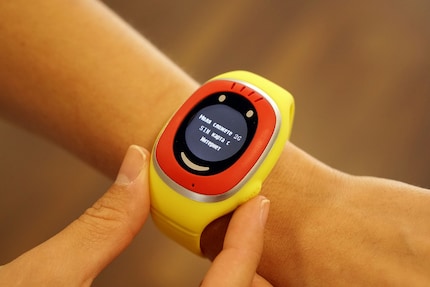
MyKi is a brand that belongs to the Bulgarian group Allterco Robotics. Was the Russian who gave us the watch Bulgarian? We don't know. But we suspect that in the former USSR and its neighbouring countries, children of people who can afford smartwatches for children are more likely to be at risk. A quick search shows that this does indeed seem to be a problem that countries have to deal with. How big the problem is, however, is unknown. Obviously big enough to be worth doing business with. Or we are faced with a chicken/egg question. Which came first? Fear of child abduction, which then led to smartwatches? Or smartwatches that sell parents not just devices but also a worry?
Let's put it this way: if you have more information on the topic, maybe even come from the Eastern Bloc yourself, let us know in a comment or send me an email. Because it's always interesting.
The watch starts up after the jingle and immediately warns that no SIM card is inserted. Let's ignore that, because I don't necessarily trust a mysterious Russian Bulgarian device that was just thrust into my hand and whose express purpose is surveillance.
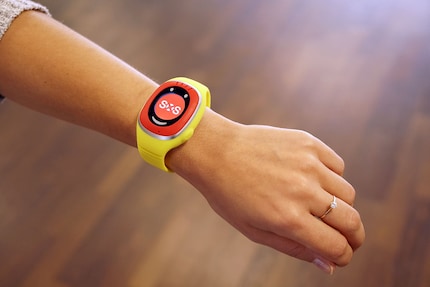
Testing it on my wrist will be difficult, because the word "slim" is one that is not generally associated with me. I'm a weightlifter and strongman athlete. That's why I look for a narrow wrist: digital media designer Pascale Anderegg has fine hands. They are certainly attached to narrow wrists.
Fits!
The functions are straightforward and designed to transmit small amounts of data even when reception is poor. The GPS system cannot be switched off. The settings are generally straightforward:
Other information cannot be read out. Not even what operating system is running on the watch. It feels half like an Android distro, which is a far cry from Android Wear, if Android Wear has anything to do with it at all. The user interface is nothing like anything I or anyone else in the office has seen before. But we don't believe in a homebrew.
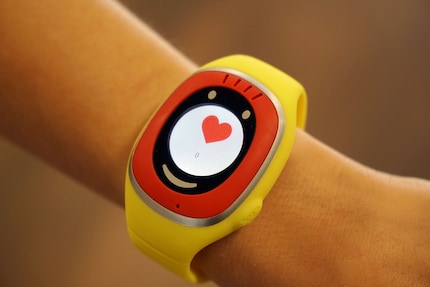
Other features of the watch:
I have questions, especially about the heart rate monitor, which is always set to zero. Because assuming my child has disappeared from the scene and I check my child's data on my smartphone and I get the message "Heart rate: 0", then I do worry. Because that means my child is dead, even if they've just popped into Migros with their colleague to buy some iced tea. I wouldn't wish that on any parent.
This all sounds quite funny and "Hahahaha! Oh my God, how funny", but it makes perfect sense in the context of a kidnapping scenario, if we continue to assume that this is indeed a problem in the society of Bulgaria-Russia.
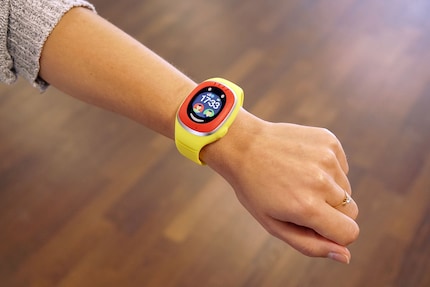
Or even just in the context of children who are growing up with smart devices and over whom the parents want some control. Because the centrepiece of MyKi is not the watch, on which virtually nothing works, but the app for the parents' smartphone. The app is available for Google Android and Apple iOS and has all the features that a modern smartwatch user would expect on the watch.
This is where the watch gets really clever. From the basic data that the watch transmits, the data is processed and interpreted with regard to child safety. The prime example of this is the speed limit.
The watch transmits the position of the child, or the digital media designer with a fine wrist, to the smartphone in real time. There, the smartphone calculates the data and a maximum speed can be set. In other words, if the digital media designer accelerates to more than the eight kilometres per hour I have set, the alarm bells on my mobile go off.
If Pascale now uses a bus, I am warned that she is no longer travelling on foot. If we now apply this to a child playing outside, the alarm goes off as soon as the child is travelling in a motorised vehicle. As children generally rarely drive motorised vehicles, this is certainly something that parents would probably like to know.
Safe zones can also be defined. For example, the office building. If Pascale leaves the building, the alarm goes off. The analogy here would probably be the child and the way to school plus school.
The product management team is clear: the MyKi Watch is not for the Swiss market. Sure, we think that there are probably paranoid fathers and mothers and helicopter parents here too, but sometimes the settings of the MyKi Watch are not very adaptable to Switzerland. First and foremost: the language cannot be changed. Cyrillic characters everywhere.
This is not really a problem during use, as the MyKi Watch is designed for users who are not yet able to read. Problems arise as soon as you encounter an error message. Taking a Russian course - or was it Bulgarian? - is a bit presumptuous in my opinion.
However, the MyKi Watch has accidentally stumbled upon a processing model that probably has a future. Because when it comes to the data processing model, the MyKi Watch is ahead of its time, probably by necessity and not by design. Even if not necessarily technologically, as the device only accesses the 2G network, which will soon be dead in Switzerland.
Because in the future, the devices we carry around with us will probably only be display devices. At least if we can believe the South Korean conglomerate Samsung. What is now the world's largest chip manufacturer is fully committed to 5G and is building appliances that will run the 5G standard from the backbone to the home router. The company announced this at a press conference at the Mobile World Congress.
In the course of the 5G rollout, it will be possible to display large amounts of data on a mobile device, but not process it there. In this way, the limitations of the "device that has to fit in a trouser pocket" can be elegantly circumvented. Data storage and processing can take place in the cloud and the mobile device itself will only display data and transmit user input to the cloud.
The situation is similar with the MyKi Watch. Little happens on the device itself. Location data is sent. The data is calculated and interpreted by a much more powerful device that is in a completely different location. This means that local computing power can be saved and other elements such as the battery or display can be prioritised.
However, the MyKi Watch is far from that, even if it seems futuristic in the abstract. At least in theory.
Journalist. Author. Hacker. A storyteller searching for boundaries, secrets and taboos – putting the world to paper. Not because I can but because I can’t not.